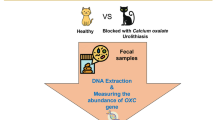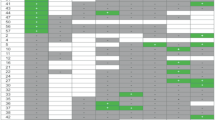Abstract
The incidence of calcium oxalate (CaOx) urolithiasis in dogs has increased steadily over the last two decades. A potential mechanism to minimize CaOx urolithiasis is to reduce enteric absorption of dietary oxalate by oxalate-metabolizing enteric bacteria. Enteric colonization of Oxalobacter formigenes, an anaerobe which exclusively relies on oxalate metabolism for energy, is correlated with absence of hyperoxaluria or CaOx urolithiasis or both in humans and laboratory animals. We thus hypothesized that decreased enteric colonization of O. formigenes is a risk factor for CaOx urolithiasis in dogs. Fecal samples from dogs with CaOx uroliths, clinically healthy, age-, breed- and gender-matched dogs, and healthy non-stone forming breed dogs were screened for the presence of O. formigenes by quantitative PCR to detect the oxalyl CoA decarboxylase (oxc) gene, and by oxalate degrading biochemical activity in fecal cultures. Prevalence of O. formigenes in dogs with CaOx uroliths was 25%, compared to 50% in clinically healthy, age-, breed- and gender-matched dogs, and 75% in healthy non-stone forming breeds. The presence of oxc genes of O. formigenes was significantly higher in healthy non-stone forming breed dogs than in the dogs with CaOx stones. Further, dogs with calcium oxalate stones and the stone-forming breed-matched controls showed comparable levels of biochemical oxalate degrading activity. We conclude that the absence of enteric colonization of O. formigenes is a risk factor for CaOx urolithiasis.



Similar content being viewed by others
Abbreviations
- PCR:
-
Polymerase chain reaction
References
Abratt VR, Reid SJ (2010) Oxalate-degrading bacteria of the human gut as probiotics in the management of kidney stone disease. Adv Appl Microbiol 72:63–87
Allison MJ, Cook HM, Milne DB, Gallagher S, Clayman RV (1986) Oxalate degradation by gastrointestinal bacteria from humans. J Nutr 116:455–460
Allison MJ, Dawson KA, Mayberry WR, Foss JG (1985) Oxalobacter formigenes gen. nov., sp. nov.: oxalate-degrading anaerobes that inhabit the gastrointestinal tract. Arch Microbiol 141:1–7
Allison MJ, Cook HM (1981) Oxalate degradation by microbes of the large bowel of herbivores: the effect of dietary oxalate. Science 212:675–676
Daniel SL, Hartman PA, Allison MJ (1987) Microbial degradation of oxalate in the gastrointestinal tracts of rats. Appl Environ Microbiol 53:1793–1797
Dawson KA, Allison MJ, Hartman PA (1980) Isolation and some characteristics of anaerobic oxalate-degrading bacteria from the rumen. Appl Environ Microbiol 40:833–839
Dobbins JW, Binder HJ (1976) Effect of bile salts and fatty acids on the colonic absorption of oxalate. Gastroenterology 70:1096–1100
Duncan SH, Richardson AJ, Kaul P, Holmes RP, Allison MJ, Stewart CS (2002) Oxalobacter formigenes and its potential role in human health. Appl Environ Microbiol 68:3841–3847
Hatch M, Gjymishka A, Salido EC, Allison MJ, Freel RW (2011) Enteric oxalate elimination is induced and oxalate is normalized in a mouse model of primary hyperoxaluria following intestinal colonization with Oxalobacter. Am J Physiol Gastrointest Liver Physiol 300(3):G461–G469
Hatch M, Cornelius J, Allison M, Sidhu H, Peck A, Freel RW (2006) Oxalobacter sp. reduces urinary oxalate excretion by promoting enteric oxalate secretion. Kidney Int 69:691–698
Holmes RP, Goodman HO, Assimos DG (2001) Contribution of dietary oxalate to urinary oxalate excretion. Kidney Int 59:270–276
Hoppe B, Groothoff JW, Hulton SA, Cochat P, Niaudet P, Kemper MJ, Deschenes G, Unwin R, Milliner D (2011) Efficacy and safety of Oxalobacter formigenes to reduce urinary oxalate in primary hyperoxaluria. Nephrol Dial Transplant 26:3609–3615
Hoppe B, Beck B, Gatter N, von Unruh G, Tischer A, Hesse A, Laube N, Kaul P, Sidhu H (2006) Oxalobacter formigenes: a potential tool for the treatment of primary hyperoxaluria type 1. Kidney Int 70:1305–1311
Kaufman DW, Kelly JP, Curhan GC, Anderson TE, Dretler SP, Preminger GM, Cave DR (2008) Oxalobacter formigenes may reduce the risk of calcium oxalate kidney stones. J Am Soc Nephrol 19:1197–1203
Kelly JP, Curhan GC, Cave DR, Anderson TE, Kaufman DW (2011) Factors related to colonization with Oxalobacter formigenes in US adults. J Endourol 25:673–679
Knight J, Jiang J, Wood KD, Holmes RP, Assimos DG (2011) Oxalate and sucralose absorption in idiopathic calcium oxalate stone formers. Urology 78:475.e9–475.e13
Kwak C, Kim HK, Kim EC, Choi MS, Kim HH (2003) Urinary oxalate levels and the enteric bacterium Oxalobacter formigenes in patients with calcium oxalate urolithiasis. Eur Urol 44:475–481
Lekcharoensuk C, Osborne CA, Lulich JP, Pusoonthornthum R, Kirk CA, Ulrich LK, Koehler LA, Carpenter KA, Swanson LL (2002) Associations between dry dietary factors and canine calcium oxalate uroliths. Am J Vet Res 63(3):330–337
Lulich JP (2009) Calcium oxalate: biological behavior and risk factor management. ACVIM Forum Proceedings 27:606–607
Lulich JP, Osborne CA, Thumchai R, Lekcharoensuk C, Ulrich LK, Koehler LA, Bird KA, Swanson LL, Nakagawa Y (1999) Epidemiology of canine calcium oxalate uroliths. Identifying risk factors. Vet Clin North Am Small Anim Pract 29:113–22, xi
Mikami K, Akakura K, Takei K, Ueda T, Mizoguchi K, Noda M, Miyake M, Ito H (2003) Association of absence of intestinal oxalate degrading bacteria with urinary calcium oxalate stone formation. Int J Urol 10:293–296
Mittal RD, Kumar R, Mittal B, Prasad R, Bhandari M (2003) Stone composition, metabolic profile and the presence of the gut-inhabiting bacterium Oxalobacter formigenes as risk factors for renal stone formation. Med Princ Pract 12(4):208–213
Osborne CA, Lulich JP, Kruger JM, Ulrich LK, Koehler LA (2009) Analysis of 451,891 canine uroliths, feline uroliths, and feline urethral plugs from 1981 to 2007: perspectives from the Minnesota Urolith Center. Vet Clin North Am Small Anim Pract 39(1):183–197
Prokopovich S, Knight J, Assimos DG, Holmes RP (2007) Variability of Oxalobacter formigenes and oxalate in stool samples. J Urol 178:2186–2190
Sidhu H, Allison MJ, Chow JM, Clark A, Peck AB (2001) Rapid reversal of hyperoxaluria in a rat model after probiotic administration of Oxalobacter formigenes. J Urol 166:1487–1491
Sidhu H, Holmes RP, Allison MJ, Peck AB (1999) Direct quantification of the enteric bacterium Oxalobacter formigenes in human fecal samples by quantitative competitive-template PCR. J Clin Microbiol 37:1503–1509
Sidhu H, Schmidt ME, Cornelius JG, Thamilselvan S, Khan SR, Hesse A, Peck AB (1999) Direct correlation between hyperoxaluria/oxalate stone disease and the absence of the gastrointestinal tract-dwelling bacterium Oxalobacter formigenes: possible prevention by gut recolonization or enzyme replacement therapy. J Am Soc Nephrol 10(Suppl 14):S334–S340
Sidhu H, Hoppe B, Hesse A, Tenbrock K, Bromme S, Rietschel E, Peck AB (1998) Absence of Oxalobacter formigenes in cystic fibrosis patients: a risk factor for hyperoxaluria. Lancet 352:1026–1029
Sidhu H, Enatska L, Ogden S, Williams WN, Allison MJ, Peck AB (1997) Evaluating children in the Ukraine for colonization with the intestinal bacterium Oxalobacter formigenes, using a polymerase chain reaction-based detection system. Mol Diagn 2:89–97
Troxel SA, Sidhu H, Kaul P, Low RK (2003) Intestinal Oxalobacter formigenes colonization in calcium oxalate stone formers and its relation to urinary oxalate. J Endourol 17:173–176
Wandzilak TR, Williams HE (1990) The hyperoxaluric syndromes. Endocrinol Metab Clin North Am 19(4):851–867
Weese JS, Palmer A (2009) Presence of Oxalobacter formigenes in the stool of healthy dogs. Vet Microbiol 137:412–413
Weese JS, Rousseau J, Weese HE (2009) Variation in shedding of Oxalobacter formigenes in feces of healthy dogs. Vet Microbiol 139:421–422
Weese JS, Weese HE, Rousseau J (2009) Identification of Oxalobacter formigenes in the faeces of healthy cats. Lett Appl Microbiol 49(6):800–802
Acknowledgments
We thank Dr. M. Allison, Iowa State University, for technical advice on anaerobic culture and for kindly providing the O. formigenes-positive culture. Dr. Carl A. Osborne, Department of Veterinary Clinical Sciences, University of Minnesota, for his vision and encouragement in initiating studies of canine urolithiasis and establishing the Urolith Center through which the animals in this study were recruited. Dr. H. Albasan and staff of Minnesota Urolith Center assisted in sample collection. Dr. R. Knurr, Department of Geology and Geophysics, University of Minnesota, performed the ion chromatographic analyses. This study was funded by the Morris Animal Foundation grants D08CA-154 and DO8CA-408.
Author information
Authors and Affiliations
Corresponding author
Rights and permissions
About this article
Cite this article
Gnanandarajah, J.S., Abrahante, J.E., Lulich, J.P. et al. Presence of Oxalobacter formigenes in the intestinal tract is associated with the absence of calcium oxalate urolith formation in dogs. Urol Res 40, 467–473 (2012). https://doi.org/10.1007/s00240-011-0451-1
Received:
Accepted:
Published:
Issue Date:
DOI: https://doi.org/10.1007/s00240-011-0451-1




